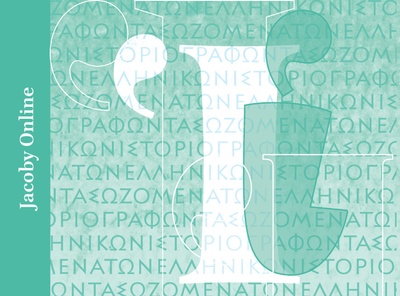
Anhänge and Appendices
Features of Jacoby's methods in developing Die Fragmente der Griechischen Historiker
In this section Brill intends to gather contributors' insights in to Jacoby's unique methods.
Extract from BNJ2 673
On Jacoby's Anhänge
Stanley Burstein
Appendices (Anhänge) are a characteristic feature of Die Fragmente der Griechischen Historiker. The purpose of the Appendices in volumes 1 to 3A is simple. They contain large blocks of text that source criticism suggests but cannot prove to derive from the work of a particular author, such as, for example, the extensive excerpts from the first book of Diodoros’ Historical Library that Jacoby included as an Appendix to the fragments of Hekataios of Abdera (FGrH 3A 264 F 25), thereby hoping to provide a fuller, albeit to some extent hypothetical, impression of the character of lost works than can be gained from studying the explicitly identified fragments alone.
The Appendices in volume 3B and especially 3C differ in character because they serve a different purpose from those in the earlier volumes because of the nature of the genres treated in those volumes: local history and ethnography (Horographie and Ethnographie). Jacoby defined their general purpose in the preface to volume 3B (FGrH 3B [Leiden 1964] 6). They were intended to provide “part of the anonymous traditional material” concerning a city, region, or people. At the same time, he pointed out that “we possess only a tiny portion of a vast literature and that the Appendices should indicate these gaps and in a, to be sure, very limited way fill them.” In the case of the Appendices in volume 3C, as he explained in the preface to that volume (FGrH 3C [Leiden 1958] 6), these general goals were carried out in a particularly expansive way so as, especially in the case of the uniquely extensive Appendices on Egypt and Aithiopia, to put before “the eyes [sc. of a reader], what one ought to expect to find, namely, beyond Hekataios, Herodotos…, the Alexander historians, …and even the Hellenistic authors…in a complete ethnography.” In effect, an Appendix such as BNJ 673 was to serve virtually as an “ideal ethnography” of the Aithiopians.
The special character of the Appendices in volumes 3B and 3C is reflected most obviously in their having their own numbers instead of being numbered sequentially with the fragments of individual authors as was done in previous volumes. They also have a unique organization, especially the ethnographic Appendices in volume 3C. Already in his famous 1909 article in Klio, On the Development of Greek Historiography and the Plan for a New Collection of the Fragments of the Greek Historians (Histos Supplement 3, translated by M. Chambers and S. Schorn [2015] 16), Jacoby had argued that ethnographies were organized in terms of a limited number of topics—land, history, wonders, and laws and customs—united only by geography and their focus on a single people. Thus, for example, the Aithiopian Appendix is organized around three topics: discovery, land and people, and mythology and history.
Especially important, however, is the peculiar treatment of the fragments themselves in Appendices such as the Aithiopian Appendix. Because of Jacoby’s view of ethnography as being primarily a descriptive genre (Development, 16-19), content instead of context was central in his editing of the ethnographic Appendices. Readers of an Appendix such as that on Aithiopia, therefore, are confronted by a topically arranged and chronologically ordered series of bare statements—sometime only fragments of sentences—and passages extracted from the works of various authors without any indication of their original context or purpose. The only reason for their inclusion in the Aithiopian Appendix is that Aithiopia or Aithiopians are mentioned in the text. The limitations of this approach are clear. While readers of such an Appendix certainly do acquire, as Jacoby intended, at least a partial sense of the content and development of the ethnographic tradition concerning a people such as the Aithiopians, they do so with little or no understanding of what that tradition meant to the authors of the works from which the Appendix was compiled.
Addendum
Stefan Schorn (Leuven)
One might add a note on the 'history' of the Anhänge: After his 1909 article, Jacoby changed his plans and wanted to edit the whole historiographic tradition. The fragmentary authors would have been only part of this project. This means that he also wanted to collect the whole tradition on single Greek cities, non-Greek lands or the campaigns of Alexander. Eduard Meyer convinced Jacoby not to do this because he thought this would have been too much work. The Anhänge are the remainders of this idea where Jacoby wanted at least to give an impression of the various traditions. On this history, see the many publications by Guido Schepens, e.g. Schepens G. (2010) Die Debatte über die Struktur der "Fragmente der griechischen Historiker". Klio 92: 427-461.